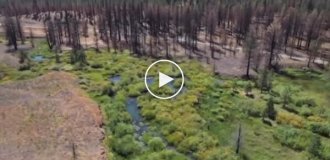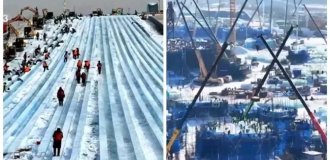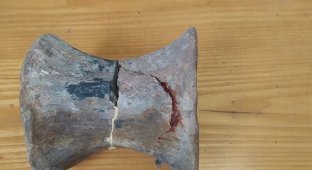Today I present to you a selection of photos that will take you back in time — to the era of change, traditions and bright events of the countries of Great Britain. It includes the best works of legendary photographers, carefully restored and colored to bring history to life. Immerse yourself in the atmosphere of the past century through these amazing photos! 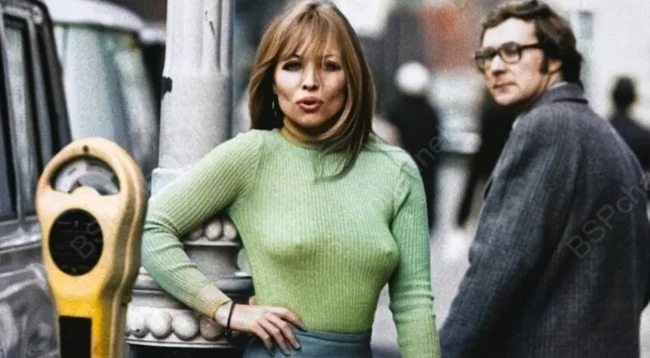
A dinosaur sculpture goes to the Prehistoric Park. Scotland, 1973. 
Photographer: Ron Burton.
Alan William Ross had an idea to build a dinosaur park in a quarry in Sittingbourne, Kent, in the 1970s. The model was created to attract attention and publicity. His idea was sponsored by many companies. Unfortunately, it took five years to get planning permission for the quarry in Kent, by which time Alan's life had changed and the project never got off the ground. The dinosaur was made from iron rods covered in wire mesh, then covered with strips of plaster. The dinosaur was then spray painted.
Hugh Pope, relaxing with his wife at their unique home, Beverley Lodge, Kingston upon Thames, Surrey, 1958. 
This unusual dome-shaped house, made of mosaic glass triangles, was Hugh Pope's personal architectural dream and the embodiment of a bold design vision.
Sunflower on the Thames. London, 1955. 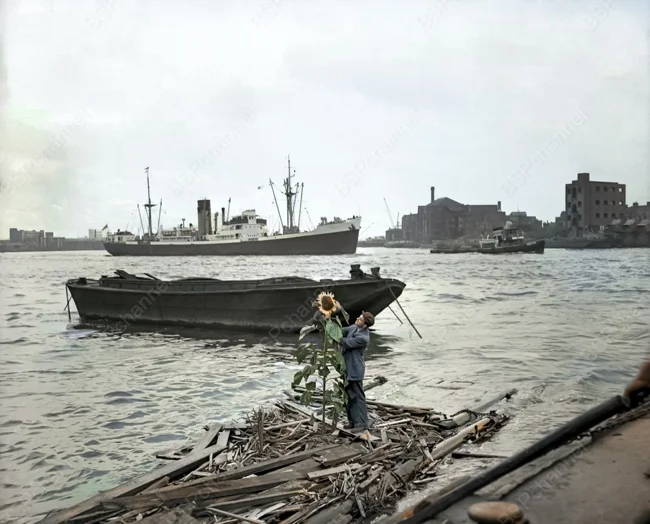
Bernard Cawthorne, a shipping surveyor from Hull, performs a forward roll over the heads of two girls who are also attending a gymnastics course at Bisham Abbey in Berkshire. UK, 1959. 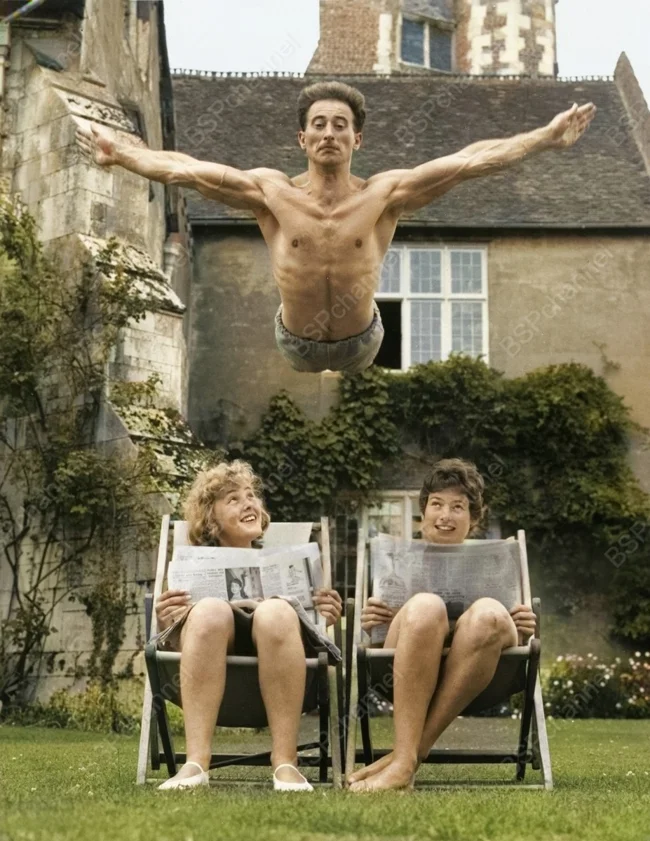
Fleet Review. Devon. UK. 1914. 
The British Navy was more than just a military force throughout the centuries and into the early 20th century – it was the backbone of imperial power, economy and global influence. Its supremacy at sea kept the empire intact and protected. However, as technology advanced and other powers, including Germany and the United States, rose to power, this dominance was gradually threatened, ushering in a new era of maritime history.
The Edinburgh University Students' Union at Teviot Row House, Scotland, 1961. 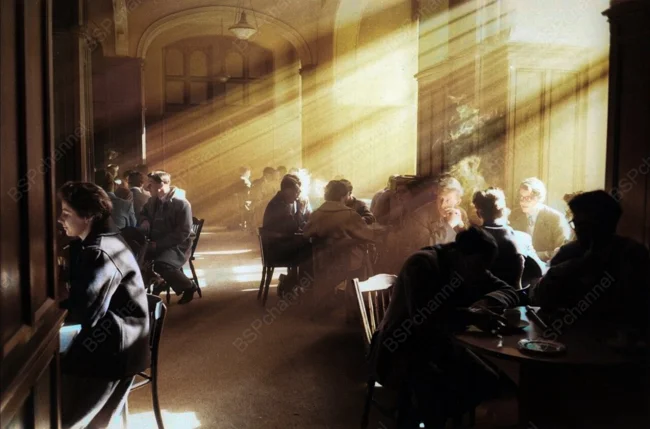
Photographer: Robert Blomfield
The aim of the union is to promote the education of Edinburgh students by representing and supporting them and by promoting their interests and their health and well-being in the community. The association is led by a team of five elected students on a voluntary basis. It was founded in 1889.
A shelter from the rain in South Wales, 1974. 
Photographer: David Hurn
Canals and waterways of the Midlands. UK, 1959. 
Photographer: Peter Thwaites
Today, the vast network of canals that served as Britain's main transport artery for centuries has become a popular tourist attraction. In the 1980s, under Margaret Thatcher, many of these waterways were neglected. They were cleared and restored by unemployed people as part of the government’s unemployment programme. This was the beginning of a major revival. The abandoned canals were gradually brought back to life. Today, they not only beautify the country, but also bring real benefits – attracting tourists, creating jobs and bringing income to local economies. Photo description from the photo bank: For some, the canal is no fun. Life is hard and the hours are long. But there are pluses. Instead of the roar of cars, Charles Foster and his son Horace hear only the murmur of slowly flowing water and the clatter of hooves. Together with their horse Betty, they work on barges, guiding them along the canals of the Black Country.
Workers laying thatch on a roof. Devon, England, 1959. 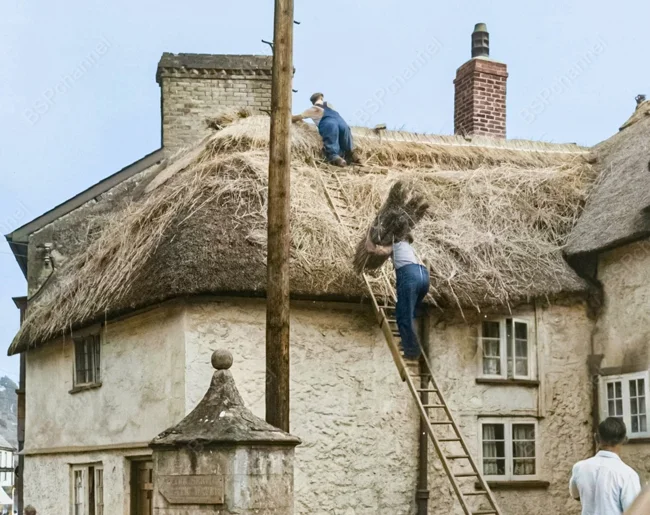
Photographer: G. Packham
British actress Barbara Windsor and British drama school student Patricia Stark ride the Water Chute at the Battersea Festival Gardens fair in London, England, 1955. 
Photographer: John Pratt
View of Whitby Harbour, England, 1974. 
Photographer: Ian Berry
On plywood down a hill. Wales, UK, 1977. 
Photographer: David Hearn
Fylingdale, Yorkshire, England, 1978. 
Photographer: Martina Frank
Gambling. London, 1956. 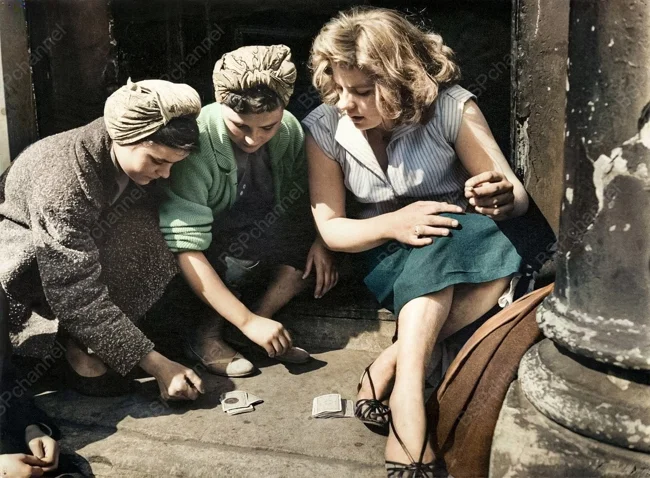
Photographer: Roger Main
Three generations of miners in a Welsh mining town. UK, 1950. 
Photographer: W. Eugene Smith
Mining in Wales was an important source of income for the Welsh economy throughout the 19th century and early to mid-20th century. It played a key role in the Industrial Revolution in Wales and throughout the UK. Wales was renowned for its coal mining in the Rhondda Valley, the South Wales Valleys and the South Wales Coalfields. By 1913, Barry had become the largest coal exporting port in the world, with Cardiff a close second as coal was transported by rail. Today, there is only one working colliery in the country.
A hotel in Devon, England, 1904. 
Dismantled buses and trolleybuses converted into accommodation on Talacre Beach, two miles from Prestatyn. UK, 1959. 
Today, Talacre Beach in North Wales is a picturesque spot with wide, golden sands, popular with tourists and a haven for wildlife. But it wasn’t always like that. In the past, it was known as the ‘slum by the sea’. The first summer chalets appeared here in the early 1930s on a wild patch of land near the mouth of the River Dee, on the edge of Liverpool Bay. However, with the outbreak of the Second World War, the area known as the Warren was transformed into a shelter for evacuees - mainly families from Liverpool and Merseyside, fleeing the bombing of ports and shipyards. People made do as best they could: they used old vans, railway carriages and even buses, turning them into houses. Despite the complete lack of centralized water and electricity, the Warren was officially recognized as a military camp. After the end of the war, people lived in such conditions for many decades, and it was not until the late 1970s that this bus and garage town was demolished.
Railway on a viaduct. Settle Carlisle, Yorkshire, 1986. 
Photographer: Denis Thorpe
The viaduct was designed by John Sidney Crossley, the Midland Railway's chief engineer, who was responsible for the design and construction of all major structures on the line. The viaduct was necessary due to the difficult terrain. Construction began in late 1869. The work required a large number of people - up to 2,300, most of whom lived in slums built at the base of the viaduct. More than 100 people died during construction. The Settle to Carlisle line was the last major railway in Britain to be built primarily by hand.
English film and television actress Susan Shaw, 1975. 
Photographer: Tim Graham
English model, actress and television presenter Leila Williams poses in a swimsuit while sitting in a boat on the River Thames in England in 1959. 
Photographer: Allen Newton
Add your comment
You might be interested in:







